 |
Zitadelle Jülich
Jülich, Germany
|
|
 |
Constructed: 1547-1580
Used by: German Dukes & Princes & Such, Spain, France, Prussia
Conflicts in which it participated:
Jülich-Klevischer Succession Dispute,
French Revolutionary Wars
|
Until the 20th century, continental Europe was a squabbling mass of unfortunate people ruled by way too many greedy, single-mindedly self-interested monarchs.
This dynamic was great for military technology: It's the reason the starfort was invented! This dynamic is not so great for a poor dumb American in the 21st century, trying to make sense of the convoluted, endless turf wars that are Europe's history. But this dumb American is willing to try! |
 |
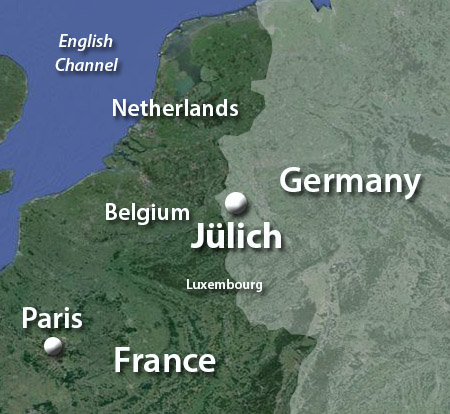 |
|
In the 1530s, local bigshot Wilhelm V (1516-1592), Duke of Jülich-Kleve-Berg, was actively consolidating his domain, as was the wont of such noble personages as he. The Duke went a step too far in 1539, capturing the Duchy of Guelders, a portion of land in what is today the Netherlands. This was territory that King Charles V (1500-1558) of Spain considered to be his personal property, and the vast armies of the Holy Roman Empire were mobilized against poor Wilhelm V in 1543, despite both he and Charles having a 'V' in their title, which would seem to deserve at least a little communal goodwill. But apparently not.
The modern artillery of Charles V's army made short work of Wilhelm's older, traditional fortifications. Wilhelm conceded defeat, even going so far as to marry a Habsburg in penance, from Charles V's extended family.
|
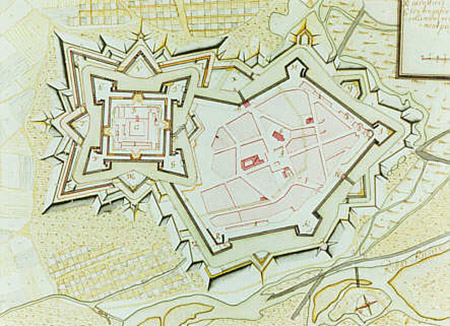 Festung Jülich Festung Jülich |
 |
Once the dust had settled and Charles V was assumedly no longer paying attention, Wilhelm V got busy on the modernization of his fortifications. He hired Italian architect Alessandro Pasqualini (1493-1559), who had made a name for himself as a designer of starry forts in the Netherlands. Wilhelm set about improving the defenses of Dusseldorf and the nearby Duchys of Kleve and Berg, but for Jülich, he and Pasqualini had grander plans.
The fondest wish of the Renaissance-era fortification expert was to build not just a starfort, but an entire city of angled, pointy strength. The fort itself would serve merely as the citadel of this fortified city, or zitadelle. |
|
|
The irksome problem that there already existed an old-fashioned, non-Renaissancey city of Jülich was conveniently solved in 1547, when the city mysteriously burned to the ground. Well darn, said Wilhelm, guess we'll have to build that fortified city now!
The finished product was somewhat diminished from Pasqualini's original plan due to finances, but by 1580 Jülich was a world-class fortified city, indeed the most modern fortress in Europe, complete with a lovely four-pointed starfort as its citadel.
|
Many royal eyeballs were watching in 1610, when an army composed of Dutch and French troops besieged Jülich as part of the snappily-named Jülich-Klevischer Succession Dispute. Johann Wilhelm (1562-1609), Wilhelm V's son, had died with no clear heir. This was extremely inconsiderate behavior, which led to a variety of dudes with funny names claiming the title of Duke of Jülich-Kleve-Berg. So internationally unsettling was this dispute that France, Spain and the Netherlands all managed to involve themselves in the conflict.
The coolest, most modern fortification system in Europe held out for a whole entire month, but capitulated on September 2, 1610 due to a lack of supplies: Nobody therein had seriously expected a siege, so had not prepared for one.
|
 |
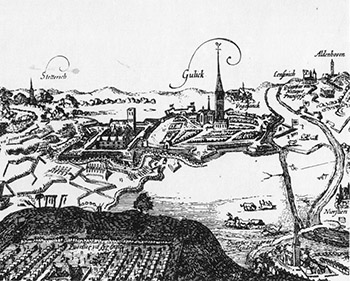 The siege of Jülich, 1610 The siege of Jülich, 1610 |
|
The armies of Spain returned in 1621, determined to remove the Dutch from Jülich. This time the besieged actually put up a fight, successfully deterring the wishes of the dirty Spanish through the winter of 1621, but the Dutch were finally overwhelmed in the spring of 1622. Spain remained in Jülich until 1660, their halberds sharp, their helmets pushed forward in a haughty manner. The succession issues of the Duchys of Jülich-Kleve-Berg weren't completely resolved until 1672.
|
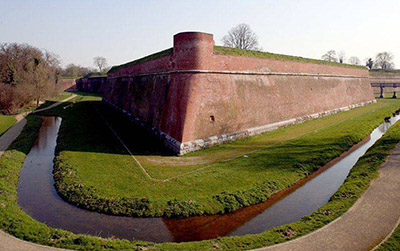
Zitadelle Jülich's Bastion of St. John, or Bastion No. IV. You call that a moat, St. John?! |
 |
Jülich spent the next century under the control of Bavarian nobles. By 1794 the fortifications were in a poor state of repair, and when the armies of Revolutionary France showed up, the town and Zitadelle were given up without a fight.
The French were nothing if not dutiful fortbuilders. They spent the next twenty years excitedly making plans for the rebuilding and improvement of Festung (fortress) Jülich, but had only barely gotten started building things when Napoleon (1769-1821) was finally put down like the mad dog he debatably was.
|
|
|
Prussia was more than happy to pick up the slack when it took over Jülich in 1815, completing the modification and modernization work begun by the French.
When looking at a satellite image of the city of Jülich today, one sees little to suggest that there was ever anything to the town's fortification beyond the Zitadelle. This is because of an exciting and no doubt unbearably noisy exercise carried out by the Prussian military in 1860. Concerned about the potential impact of modern, breech-loading rifled artillery on even the most recently-constructed fortifications, they conducted a faux siege, in which they completely pulverized every scrap of Festung Jülich.
|
Lessons learned in this exercise were helpful in Prussia's complete immolation of France's silly army in the Franco-Prussian War (1871).
In the 1920's, French and Belgian troops were stationed at the Zitadelle, as part of the occupation that followed the First World War (1914-1918).
The Zitadelle's casemates were used as air raid shelters during the Second World War (1939-1945), not completely successfully: A number of civilians died therein during Allied bombing raids in 1944.
|
 |
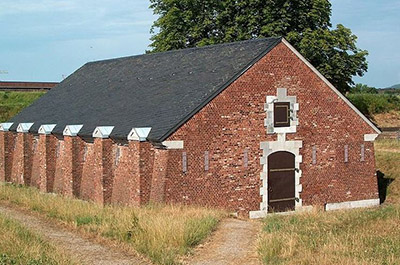 Zitadelle Jülich's pulvermagazin (powder magazine), which dates to the French era Zitadelle Jülich's pulvermagazin (powder magazine), which dates to the French era |
|
|
All starforts need to undergo a period of sorrowful 20th century neglect in order to prove their worthiness as a national treasure. The Zitadelle's such period lasted the two decades after the Second World War, but it was saved from the fate of many overgrown, forgotten European forts by its rechristening as the new seat of the State High School in the late 1960's.
|
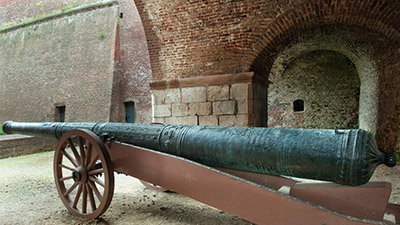 A ridiculous gun within Zitadelle Jülich. Whom exactly do you suppose you're kidding, Zitadelle? A ridiculous gun within Zitadelle Jülich. Whom exactly do you suppose you're kidding, Zitadelle? |
 |
Twas determined that the Zitadelle should be rebuilt in the early 1980's, a plan that was executed with more enthusiasm than skill. Shoddy materials and poor workmanship created more problems than they solved, but by the 1990's a more serious approach was taken, and the reconstruction effort was completed with a typically Germanic attention to detail and quality.
Today, Zitadelle Jülich is a tourist and cultural center, with a museum, sports field and school. It is one of only two structures in Jülich to have survived the Second World War.
|
|
|
|
|
|
|
|
 |




